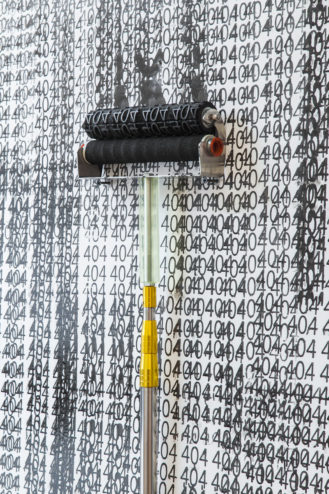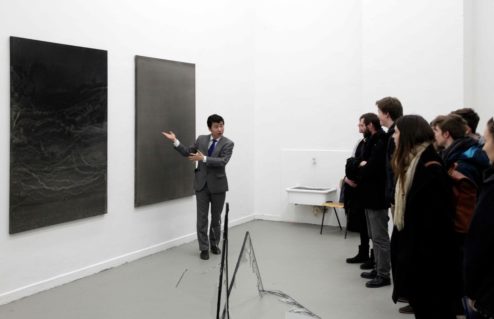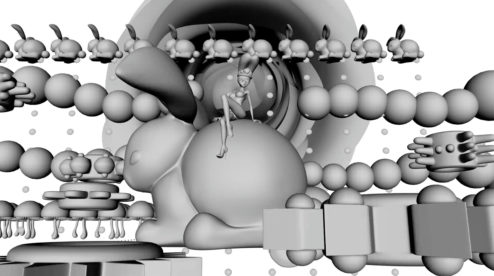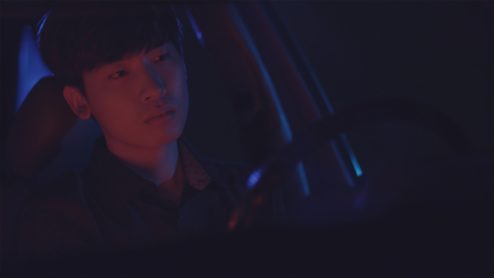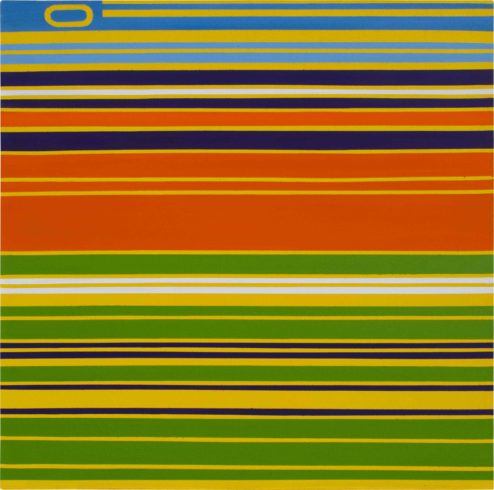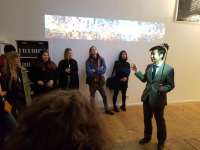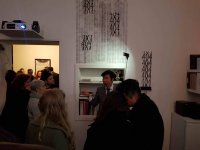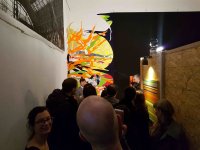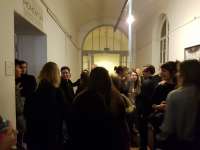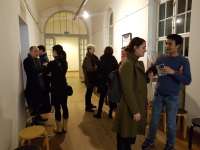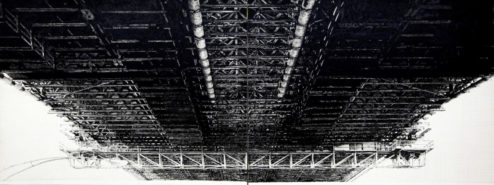
STATION PARADOX
A dialogue between artists from Korea and the MOMENTUM Collection.
aaajiao <> Claudia CHASELING <> JANG Jaerok <> Kira KIM + Hyungkyu KIM <> Zinu KIM <> David KRIPPENDORFF <> Hye Rim LEE <> Milovan Destil MARKOVIĆ <> Jihye PARK
Curated by Rachel Rits-Volloch & Jung Me Chai, Assistant Curator, Gyusik Lee
OPENING: 26 January 2018 @ 7:00 – 11:00pm
ARTIST TALK: 28 January @ 3:30 – 4:30pm
STATION PARADOX Explained: Jung Me Chai, JANG Jaerok, Zinu KIM, David KRIPPENDORFF, Gyusik LEE, Rachel Rits-Volloch
EXHIBITION: 27 January – 11 March 2018
@ MOMENTUM
Kunstquartier Bethanein
Mariannenplatz 2, Berlin 10997

 |
This exhibition is a dialogue between artists from Korea and from Berlin working with painting, video art, installation, and performance. As the title suggests, cultural dialogue can often highlight the paradoxes inherent to questions of identity and shifting perspectives. The artists selected for this exhibition, each in their own way, push the boundaries of the expected: from Claudia Chaseling’s spatial paintings spilling out of the canvas and exploding off the gallery walls; to the transfigurative paintings of Milovan Destil Markovic, translating a digital language onto his canvases; the hyperrealist calligraphic ink painting of Jang Jaerok; the meditative emotional journeys of Jihye Park’s and David Krippendorff’s films; the socially conscious videos of Kira Kim and Hyungkyu Kim; the zany performances of Zinu Kim; the digital animations of Hye Rim Lee; and aaajiao’s interrogation of our post-internet culture. The works in this exhibition push the limits of their form, highlighting the paradoxes in how we perceive the world through the shifting perspectives of cultural landscapes mediated through technologies of viewing. Nothing here is quite what it seems.
The exhibition will be accompanied by a dual language (english/korean) catalogue. The opening of STATION PARADOX on 26 January 2018 coincides with the opening of the CTM Festival of Digital Culture, also at the Kunstquartier Bethanien. By way of this exhibition, MOMENTUM is proud to show works by three artists never before seen in Berlin – Jang Jaerok, Hyungkyu Kim, and Jihye Park – and to welcome four new artists and their works to the MOMENTUM Collection – aaajiao, Claudia Chaseling, David Krippendorff, and Milovan Destil Marković.
 |
ARTISTS and their WORKS
404 (2017), ink, sponge roller, dimensions variable
404 is the error message which appears on blocked websites in China. Translating the digital message back into analog form, 404 (2017) is aaajiao’s subtle commentary on censorship and the flow of information in our digital culture. The message is always the same, no matter the diversity of content it is covering from view. Entirely site-specific, this work takes a new form with each installation; multiplying the message 404 in a diversity of forms and contexts.
Active online as a media artist, blogger, activist and programmer, aaajiao’s practice is marked by a strong dystopian awareness. His work speaks to new thinking, controversies and phenomena around the Internet, the processing of data, the blogosphere, and China’s Great Fire Wall. aaajiao’s work is interdisciplinary, extending from post-internet art to architecture, topography, design, and beyond to capture the pulse of the young generations consuming cyber technology and living in social media.
aaajiao, born 1984 in Xi’an, China, is the virtual persona of Shanghai and Berlin-based artist Xu Wenkai. aaajiao’s work has been featured in numerous exhibitions around the world. Upcoming and recent shows include: Art in the Age of the Internet, 1989 to Today, The Institute of Contemporary Art, Boston (2018); unREAL, Haus der Elektronischen Künste, Basel (2017); Shanghai Project Part II, Shanghai (2017); Temporal Turn: Art and Speculation in Contemporary Asia, Spencer Museum of Art, Kansas (2016); Take Me (I’m Yours) (curated by Hans Ulrich Obrist, Jens Hoffmann and Kelly Taxter), Jewish Museum, New York (2016); Overpop, Yuz Museum, Shanghai (2016); Hack Space (curated by Hans Ulrich Obrist and Amira Gad), K11 Art Foundation Pop-up Space, Hong Kong and K11 Art Museum, Shanghai (2016); Globale: Global Control and Censorship, ZKM | Centre for Art and Media, Karlsruhe (2015); Thingworld International Triennial of New Media Art, The National Art Museum of China, Beijing (2014); and Transmediale, Berlin (2010). His solo exhibition includes: Remnants of an Electronic Past, Centre for Chinese Contemporary Art, Manchester (2016); OCAT Contemporary Art Terminal Xi’an, Xi’an (2016), among others. He was awarded the Art Sanya Awards in 2014 Jury Prize, and was nominated for the first edition of OCAT-Pierre Huber Art Prize in 2014.
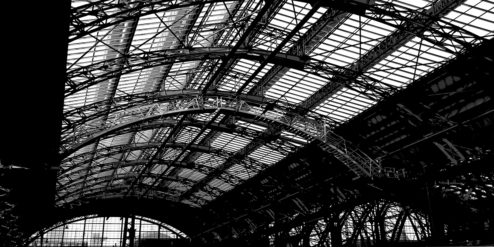
Another Landscape-Frankfurt Hbf (2018), Korean ink and Acrylic on Korean Paper, 360 x 180 cm
Jang Jaerok, since his early career, has examined everyday life in capitalist societies through contemporary images made from traditional Korean ink painting. What appear to be black and white photos are actually photo-realist ink paintings expressed meticulously through light and shade of ink. His subject is largely the material objects of desire: luxury cars, jewels, chandeliers, and monumental industrial architecture. JAEROK characterises his mission as an artist as “The method I use is Asian painting. Asian painting is neither an imitation of nature nor expression of mind, which is different from the method of Western paintings. At the same time, I explore the world through the pixels of images. I use traditional Asian painting as a form, and for content, I examine the reality of the absurd human civilization that has been mythicized in the name of rationality. The form is photographic images fabricated by the 0s and 1s of the binary system. I question the issues of the 21st century, in the firm belief of the dialectical pattern of the immense human history.”
“Jang was fascinated by huge artificial structures and sophisticated machines. Consequently, his Korean paintings somewhat look like architectural drawings on graph paper measured with a ruler. In his paintings, we cannot find traditional features of Asian painting like drawing with one stroke of a brush or cheerful vitality. We live in a world full of machinery and artificial structures. He does not only show surface of neatly cut machines or structures; they feel like bizarre, scary anatomical charts of human body.” (Another Landscape (Brooklyn Bridge) catalog text, Busan Biennale).
Jang Jaerok is a Korean artist born in Seoul in 1978. He lives and works in Seoul, Korea. Jaerok’s artistic sense has been inspired since childhood by his mother who is a traditional calligrapher. He completed a BA in Asian painting at Dan-kook University and an MA at Hong-ik University. He is currently a PhD candidate in art at Hong-ik University. He has exhibited at many museums in Korea including the Seoul Museum of Art, Gansong Museum, Gyeonggi Museum of Modern Art, Gyeongnam Art Museum, and the Pohang Museum of Steel Art. Recently he participated in the main exhibition at the Busan Biennale (2016) where he extended his work by adding installation to his traditional Korean ink painting of contemporary images. Recent international exhibitions include: Westwerk e.v., Hamburg, Germany (2016); Musee Adam Mickiewicz, Paris, France (2016); and other museums and galleries in China, Japan, Germany, and New York.
Take a Docent Tour (2018), site specific performance
Zinu Kim has worked as a tour guide and docent at museums and galleries in Germany since 2008. For this exhibition, he will make a series of guide performances, acting as a docent at the exhibition. He will be helping visitors appreciate the exhibition as a performer, occupying the space somewhere between the artworks and the audience. Reprising his role as a gallery guide, Zinu Kim’s performance at the exhibition engenders a wilful ambiguity between what some may perceive as a docent tour, while others might experience it as art. In this direct address to the audience, the artist poses the question, when an artist does a performance that is closely linked to his or her job for a living, how will the audience draw the line between art and life?
Zinu Kim was born in South Korea in 1979. He studied Oriental Painting at Seoul National University in Seoul, Korea, and Fine Art at Hochschule für Bildende Kunst in Hamburg, Germany. Sine 2016, he has worked and lived in Berlin. He creates paintings that combine two different cultures: German and Korean. He also does performances to share ideas and topics found in his everyday life. Zinu Kim has shown his works in exhibitions in Berlin, Hamburg, Cologne, and Korea.
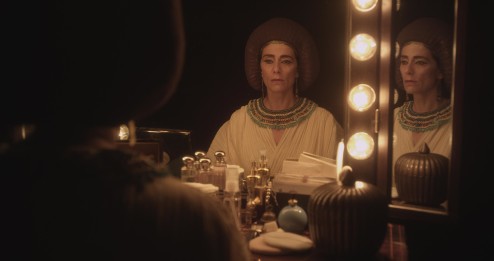
Nothing Escapes My Eyes (2015), HD Video, 13’43”
Nothing Escapes My Eyes is about a silent transformation of a place and a human being. Inspired by the texts of Edward W. Said, the poems of Mahmoud Darwish and Verdi’s opera Aida, the film depicts in a metaphoric form current issues of cultural identity, loss and the pressures to conform. With no dialogue, the film is backed by a musical excerpt from Aida whose lyrics express the difficulties of being loyal to one’s country and cultural identity. The personal and urban transformation tackles on issues of identity, loss and disorientation as a result of historical colonialism and contemporary globalization.
David Krippendorff, born in Berlin in 1967, is a US/German interdisciplinary artist and experimental filmmaker. Currently based in Berlin, he grew up in Rome, Italy, and studied art at the University of Fine Arts in Berlin, Germany, where he graduated with a masters degree in 1997. His works, films and videos have been shown internationally, including: the New Museum (New York), ICA (London), Hamburger Kunsthalle (Hamburg), Museum on the Seam (Jerusalem). He has participated in four Biennials (Prague, Poznan, Tel Aviv, and Belgrade), as well as in many international art and film festivals worldwide.
Black Rose v1 (2016), 3D digital animation, 4’45”
Hye Rim Lee’s work questions the role of new technology in image-making and representation, reviewing aspects of popular culture in relation to notions of femininity and looking at the way fictional animated identities are propagated within contemporary culture. Her work has developed through the critical and conceptual evolution of her animated character TOKI, the principal component of her ongoing TOKI/Cyborg Project (2002-present). Hye Rim has positioned her work at a progressive interface between Eastern and Western popular culture, and the exploration of how new technologies, through the intersection of computer gaming, cyber culture, and animamix, influence contemporary myth-making. Black Rose v1 continues the ongoing TOKI mythscape, with a soundtrack composed by Hye Rim Lee and Jiyeon Won. TOKI’s story is a narrative of an infinite dream where TOKI the shapeshifter afloat in her fantasy world, becomes a Princess, a Queen and a Rose.
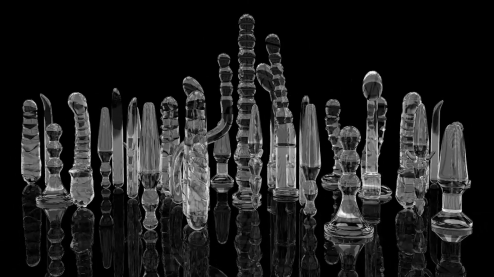
Crystal City Spun (2008), 3D digital animation, 3’17”
An earlier work from the TOKI/Cyborg Project, Crystal City Spun opens with a cityscape of spinning dildo towers. Out of the landscape emerges TOKI, a highly stylized curvaceous, warrior-cum-vixen who draws upon the Japanese tradition of Manga, Korean animamix and Western ideals of sexuality and beauty. TOKI exists in a fantasyland ripe with sexual energy. To sadistically erotic effect, a dragon taps TOKI’s exposed nipple with the tip of his pointy claw. This titillation sends TOKI into a pirouette. She stops only when whipped by the dragon’s whiskers, sparking the crystallization of both the landscape and its characters. Steeped in sexual innuendo, Crystal City Spun is a fantasyland where dream and reality mix. The video has a paradoxically playful, childlike quality invoking fantasy and toys, while alluding to the darker side of obsession and addiction. Hye Rim Lee’s ongoing series challenges the conventions of the traditionally male-dominated worlds of game structure and 3D animation, specifically when it comes to virtualized images of women.
Hye Rim Lee was born in Seoul, Korea, and is based between New York, Auckland (New Zealand), and Seoul. She graduated with degrees in time-based arts and music from, respectively, the Elam School of Fine Arts, The University of Auckland, New Zealand (2003) and the Ewha Women’s University, Seoul, Korea (1985). Hye Rim Lee’s work has been exhibited widely in solo and group exhibitions at: Kukje Gallery Seoul; Max Lang Gallery, New York; Kate Shin New York; Freight+Volume, New York; Gallerie Volker Diehl, Berlin; Monte Clark Gallery, Vancouver; MoCA Shanghai; Today Art Museum, Beijing; Fundacio Joan Miro, Barcelona; Starkwhite Gallery, Auckland, New Zealand; Gow Langsford Gallery, Auckland, NZ; San Jose Museum of Art, USA; Museum of Contemporary Art, Seoul, Korea; SeMA, Seoul, Korea; Govett Brewster Art Gallery, New Plymouth, NZ; Adam Art Gallery, Wellington, NZ. She has participated in numerous international Biennales, including: collateral exhibitions in the 54th and 53rd Venice Biennales; the Incheon Women’s Art Biennale, Incheon, Korea; Animamix Biennale, China (2011); Samsung Media Exhibition, Daegu, Korea (2011); The World Expo (2010), Shanghai. Hye Rim was awarded Artist Residencies at Ssamzie Space, Seoul, and at ISCP, New York. She was a Visiting Fellow at Auckland University of Technology in 2013, and was a finalist of the Wallace Art Awards in 2016. Hye Rim Lee’s works are held by major public and private collections, including: SeMA (Seoul Museum of Art) Korea; Govett-Brewster Art Gallery, New Plymouth, New Zealan; Adam Art Gallery, Wellington, NZ; Te Papa (The National Museum of New Zealand) Wellington; The University of Auckland, NZ; Ernst&Young, NZ; Saatchi&Saatchi NZ; Hara Museum, Japan: National Museum of Contemporary Art Korea (MMCA); Byron Aceman Collection (BAC), Canada. Hye Rim Lee currently works with Venice Projects, Venice, Italy; 12 Gallery, Queenstown/Auckland, NZ; and Waterfall Mansion & Gallery, New York.
Rumination (2017), HD video, 6’30”
Rumination captures a man from various angles who has a deadpan face and seems lost in thought. In this video work, Jihye Park intends to interpret the multilayered psychological state of anxiety caused by underlying conflicts in our closest relationships and our desire for possession as “the moment of absence”. Jihye Park, throughout her practice as a video artist, explores relationships and their reciprocity. Her contemplations of relationships are not about grandiose interactions, but are about those close to our everyday lives such as dating, love, jealousy, sympathy, etc. The most intimate of relationships are the spatial identities that are infused with unfathomable levels of convention, mythology, and formalities. The seemingly simple person-to-person meeting ground is actually festered with underlying basic conflicts, a complicated and complex place where innumerous conventions and desires that control individuals collide, exchange, and compromise with the other. The violence that lies concealed in such familiar and close relationships is all the more dangerous because it is masked, and because it is born of intimacy. Through this form of violence concealed in everyday life, Park investigates the identity of the potential desire that exists within the relationship between human beings and while the work does not portray a distinct event it does exude a rather bizarre sense of psychological unease.
Jihye Park was born in Busan in 1981 and currently lives and works in Seoul. She received both undergraduate and graduate degrees from Goldsmiths, University of London. Jihye Park portrays a human’s psychological state driven by his/her underlying desire, and the conflicting and contradictory emotions a human undergoes using the video format. She combines symbolic elements from fairytales/fables, myth, actual incidents and personal experiences to recreate the essence of ambition and lust dormant in close relationships. Her works have been shown internationally, including: La Compagnie, (Marseille, France); Westwerk e.V, (Hamburg, Germany); Busan Biennale, (Busan, Korea); OVNi, (Nice, France); Sanshang Contemporary Art Museum, (Hangzhou, China); Art Stage Singapore, Korea Platform, (Singapore, Singapore); SongEun Artspace, (Seoul, Korea); Korean Cultural Centre, (London, UK); Foundation for Indian Contemporary Art (FICA), (New Delhi, India); Museum of Contemporary Art of Rome, (Rome, Italy). She is currently participating at Seongnam Cultural Foundation Residency program, Creative space of public art Sinheungdong.
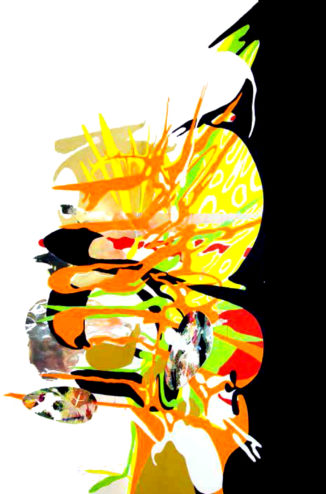
yesterday is tomorrow (2018),
leaf aluminium, aluminium, egg tempera and oil on wall, floor and 2 oviform canvasses; 500 x 200 x 300 cm
Claudia Chaseling’s practice is characterised as Spatial Painting. At once 2- and 3-dimensional, her work encompasses painting, sculpture, and installation; the works leaping off the gallery walls. Chaseling creates swirls of organic from, upside down landscapes with reversed perspective and bright fluorescent wave structures with political content. The imagery of her Spatial Paintings consists of distorted landscapes, estranged places, mutated creatures and plants whose deformation is caused by radioactive poisoning. Her images, often including text and URLs referencing her source materials, are not predictions of some post-apacalyptic future, but rather the result of her research into historic and ongoing ways in which we continue to poison our planet with radioactive materials. yesterday is tomorrow (2018) is a new site specific work made especially for this exhibition. This spatial painting has a particular view point from which the work is composed. Seen from this single point, optically, the work looks paradoxically flat. Yet stepping out of this particular persecutive, the work explodes off the gallery walls, melting onto the floor, oozing onto the adjacent wall. Contained within the 2 small oviform paintings within the work, are two links to online sources for the artist’s research into depleted uranium. One leads to the documentary by Frieder Wagner about the use of depleted uranium munitions:
https://www.youtube.com/watch?v=djv8UyrrC34 >>.
The other link leads to an article about how the west historically and currently uses other countries to test their weapons:
https://www.theguardian.com/commentisfree/2017/apr/14/military-weapons-history-the-west-bombs >>.
The imagery in both paintings is of the MOB bomb that was dropped on Afghanistan in 2017, and surrounding the landscape.
Claudia Chaseling is a German artist, born in Munich in 1973, currently living and working between Berlin, Germany and Canberra, Australia. She is known for developing the practice of Spatial Painting, comprised of canvases and sculptural paintings with mixed media on objects, walls and floors. The artist has exhibited her works in over fifty solo and group exhibitions, notably in the United States, Australia, Germany, Sweden, Luxembourg, Austria, Switzerland, and beyond. Recent exhibitions in 2017 include solo exhibitions at Magic Beans Gallery in Berlin, and the Wollongong Art Gallery, Australia, as well as a group exhibition at Richard Taittinger Gallery, New York. The “Verlag für zeitgenoessische Kunst und Theorie” published her first extensive monograph in 2016.
Claudia Chaseling studied at Academy for Visual Arts in Munich, Germany, and Academy of Visual Arts in Vienna, Austria, before graduating in 1999 from the University of the Arts (UdK) in Berlin, Germany. She received her Masters degree in Visual Arts from both the University of the Arts Berlin, in 2000, and the School of Art, Australian National University in Canberra, Australia, in 2003. The artist is currently completing her PhD in Visual Arts at the School of Art, Australian National University in Canberra, Australia. Major grants and scholarships received in Australia and Germany include the DAAD; the Samstag Scholarship; the Studio Award of the Karl Hofer Society; the Australia Council for the Arts Grant in 2014; and the 2015/16 artsACT Project Grant. She has taken part in various international visiting artists programs and artists residencies, including Texas A&M University; Yaddo in New York; the International Studio and Curatorial Program in New York City; the Australian National University (ANU); amongst others.
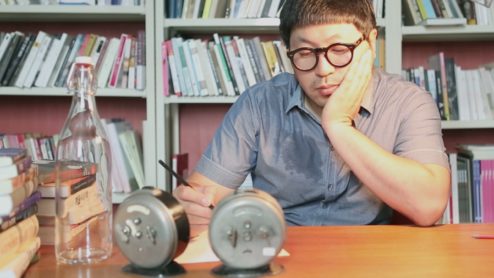
Kira KIM, A weight of Ideology _ The Letters to North _ Let me know how are you? _ On the yellow Sea (2013), HD Video, 10min
In this video work, a letter describes a brief thought on Korean North-South relations, starting from a trifling thing – naengmyeon noodles. The content of this letter addressed to an unspecific person in North Korea is banal. The narrative in this letter – that one remembered someone in North Korea when eating naengmyeon – ends with the common Korean greetings: “you don’t skip meals”. This letter, however, is not ordinary. Its content carries no serious ideology or thought. In this prologue-like work the artist asks questions such as “what are ideal North- South relations?”, and “with what ideology do we see the world?”, arguing that our discussion on unification with North Korea should be from the heart, to preserve equal, basic human life and to respect human beings, not any logic of political, national, or economic ideologies.

Kira KIM & Hyungkyu KIM X, Hear the Wind_Across the Border (2017), 4K video, 12min
Hear the Wind_Across the Border is a video using an experimental filmmaking technique called ‘360-degree time lapse’. This film portrays four symbolic sites where the Republic of Korea’s political, economic and historical contexts intersect from a contemplative view through the 2016 ‘axis of time’. In particular, the 360-degree camerawork is especially meaningful in that it captures the landscape of ‘time and space’, which human vision alone cannot capture. Such broadened perspective leads to the question of what is the eye of the camera gazing at, in other words, where is the camera located? The artists explore four sites which represent the historical and political symbolization of the Republic of Korea, recording each site using 360-degree video and making montages of them. By doing so, they capture time and space on a single screen while recording the history of the present through a novel technology of vision.
The four sites in the artist’s work reflect the ironic history and reality of the Republic of Korea in a symbolic manner. The first site, the Yongsan redevelopment area in Seoul, is a representative space which symbolizes the Republic of Korea’s shallow capitalism. The second site, the observatory at Yeonmijeong in Ganghwado, embraces the more than 500-years-long history of repeated invasions and divisions in its entirety in one place. The third, Gwanghwamun Square in Seoul, is the place where the passion for new politics was ignited in the Republic of Korea in 2016. Lastly, the DMZ (demilitarised zone between North and South Korea), is one of the places which have a sharp ideological conflict from the viewpoint of the outside world, but regardless of this political sensitivity, the wind in this area flows calmly and silently, revealing irony as if nothing ever happened in the past.
Kira Kim working together with Hyungkyu Kim ’characterise their practice as, “We are interested in the social and cultural position of an individual as well as and in the desire of a group that is contrary to that of an individual. In our work we examine historical events and human activities related to human behaviors and habits, social inequality and prejudice, the contradiction between myth and religion, ideology, and the individual. This examination is founded upon an understanding of the artist’s role in a sociocultural and political context to address and share the human nature of desire and agony with the public through art. As for methods, we would like to integrate visual art into community programming, choreography, music, and other genres. Conceptually, we are looking for the intersection where a concept develops into a form of art. Sometimes, this examination feels like it is fantasy yet it is a reflection of contemporary society shown through a language of humor and visual signs. In our projects, a multitude of cultural symbols are presented. This is to represent the spectacle of contemporary society with its social structure that is dotted with fundamental contradictions. Our spectrum of visual languages include but are not limited to: collecting, elegant painting, collage, site-specific installation, and video that deal with the history of an individual or events.”
Kira KIM was born in 1974 in Korea, and currently lives and works in Seoul. He received his BFA and MA at the Kyoungwon University of the fine Art and sculpture, in Sungnam, South Korea in 1993-2003, and eared an MA in Fine Art at Goldsmiths College, London, in 2007. International exhibitions include: the Animax Biennale (2017); ART:1 Museum Jakarta Indonesia; Artist of the Year, MMCA, Korea (2015); Transfer, Korea-NRW (2011-2012); Kunsthalle Düsseldorf (2013), Kunstverein Hagen, Germany (2013); Common good _ Every clime the mountain, Doosan Art Center, Korea (2011); Super-Mega-Factory, Kukje Gallery, Seoul (2009); A Palace of Mirages, King’s Lynn Arts Centre, UK (2009); MOCA Taipei (2014); Kaohsiung Museum of Fine Arts, Taiwan; National Museum of Contemporary Art, Korea; SEMA Seoul Museum of Art, Korea; Samsung Leeum Museum, Korea; The Guild, Mumbai, India; Liverpool Biennial, UK (2010); Minsheng Art Museum, Shanghai, China; Kunstverein Bochum, Germany; Santral Museum, Istanbul, Turkey; The Bienniel of Graphic Arts, Slovenia; Prague Biennale, Karlin Hall, Czech Republic; Fondazione Sandretto Re Rebaudengo, Italy; Nanjing Museum, China; Museo Nacional de Bellas Artes, Argentina; Museum of Contemporary Art, Chile; amongst others.
Hyungkyu KIM was born in 1983, in Yeoncheon, which is near the DMZ in South Korea. He majored in communication and media arts, and is currently working as a director of music videos, films, and advertisements in Seoul. The artist mainly focuses on the narratives, relationships and forms viewed through a camera, and is interested in contemplating the views, locations and implications of a camera based on time. Recently, he has begin studying video works that use 360-degree camerawork and flattening with multiple cameras. He was selected as one of the 3 final winners of the 2017 VH Award, participated in the Ars Electronica Residency Program, and won the Grand Prix of VH Award in 2017.
It Really Fills My Mouth / Morning (2013), pigments on canvas, 86 x 250 cm
Sunset! (2016), pigments on canvas, 70 x 70 cm. Sunset on 16.02.2016 in Bundanon, NSW, Australia.
Milovan Destil Marković’s series of Transfigurative Paintings are the result of intensive research and the attempt to develop and expand the idea of the portrait. In his ongoing series of Barcode Paintings, Markovitch uses barcodes to signify written words through colourful, bright stripes on his canvases. Every text can be translated into a barcode that is the product of a systematic process of codification, at the end of which only a rhythmic series of vertical lines remains. This abstraction allows for an international rationalized system of merchandise management, the organisation and distribution of commodities. In Marković’s work, there is a tension between the image as an abstract painting and the barcode as algorithmic script. The content of each image is revealed through the title of the painting. His works contain short text quotations from pornographic literature, politics and banking; representations of the world of power and oppression. Marković’s barcode paintings veil their content behind a normalised form; at once the language of commerce, and a kind of digital calligraphy. They can be understood either as an impish joke on the part of the artist, or as a critique of the opaque structures of markets that mask their global deficiencies and injustices. As a sly comment on the possibility of art as commodity, printed on the side of each painting is a barcode: the normal-sized, black and white version of the content of each barcode painting. In the case of the two works shown in this exhibition, Sunset! is a landscape painting, taking as its subject the date and location of a sunset witnessed by the artist while on an Artist Residency in Bundanon, NSW, Australia. While It Really Fills My Mouth / Morning is a quotation from The Sexual Life of Catherine M., the infamous autobiography of Catherine Millet (the French writer, art critic, curator, and founder and editor of the magazine Art Press).
Milovan Destil Marković was born in 1957 in Yugoslavia/Serbia. He has lived and worked in Berlin since 1986. Having studied painting at the Faculty of Fine Arts at the University of Arts, Belgrade, where he graduated in 1983. Markovic’s works can be found in numerous public and private collections throughout the world: in between others in the Contemporary Art Museum, Kumamoto/Japan; Neuer Berliner Kunstverein, Berlin/Germany; Museum of the City of Belgrade/Serbia; Istanbul Art Museum Foundation, Istanbul/Turkey; Museum of Contemporary Art, Belgrade/Serbia; Kunstmuseum Düsseldorf, Düsseldorf/Germany and Landesmuseum Joanneum, Graz/Austria, The Artists’ Museum Lodz/Poland. Markovic has exhibited extensively in Europe, Asia and in the Americas. His work was featured at 42nd Venice Biennial Aperto, 4th Istanbul Biennial, 46th Venice Biennial, 6th Triennial New Delhi, 5th Biennial Cetinje, Sao Paulo Biennial, Hamburger Bahnhof – Museum für Gegenwart Berlin, Contemporary Art Museum Kumamoto, P.S.1 Contemporary Art Center New York, Moderna Museet Stockholm, Ludwig Museum for Contemporary Art Budapest, Saarland Museum Saarbrücken, The Artists’ Museum Lodz, National Museum Prague, Museum of Contemporary Art Belgrade, Landesmuseum Graz, Kunstmuseum Duesseldorf, Art Museum Foundation – Military Museum Istanbul, Kunst-Werke Institute for Contemporary Art Berlin, Kunstverein Hamburg, Kunstvoreningen Bergen, Galleri F15 Oslo, Nishido Contemporary Art Tokyo, Fei Contemporary Art Center Shanghai, the 56th October Salon Biennial in Belgrade, and many others.
ABOUT the CURATORS
Jung Me Chai is the Founder of DISKURS Berlin, a non-profit art space and residency program which initiates, arranges, and develops an international network of contacts between the contemporary art scenes in Germany and Korea. Jung Me studied at the Kunstakademie Düsseldorf with Prof. Fritz Schwegler and at the Rietveld Academy audio visual media. From 2011 to 2013 she worked as project manager for the project “Transfer Korea – NRW ” at the NRW Kultursekretariat. She currently works as a freelance curator and as assistant curator at the Kunstmuseum Bochum. She has curated exhibitions such as: No More Daughters And Heroes, Aram Art Gallery, The Goyang Cultural Foundation, Korea // Organ Mix, Total Museum, Korea // Kleines Affektchen (Part Film, Video, Performance), Museum Bochum. She contributed articles to Wolgan Misul (Print), Artnow (Print), amongst other publications.
Dr. Rachel Rits-Volloch is a graduate of Harvard University with a BA degree in Literature and holds an M.Phil and PhD from the University of Cambridge in Film Studies. She wrote her dissertation on visceral spectatorship in contemporary cinema, focusing on the biological basis of embodiment. In 2016-2017, Rachel Rits-Volloch was Visiting Professor at the Bauhaus University, Weimar, lecturing in the MFA program “Public Art and New Artistic Strategies” and the PhD program in Artistic Research. Rachel Rits-Volloch founded MOMENTUM in 2010 in Sydney, Australia, as a parallel event to the 17th Biennale of Sydney. MOMENTUM moved to Berlin in January 2011 as a non-profit global platform for time-based art, with headquarters at the Kunstquartier Bethanien Art Center. MOMENTUM’s mission is to continuously reassess the growing diversity and relevance of time-based practices, with an aim to support artists and artistic innovation in Berlin and worldwide. MOMENTUM’s program is composed of local and international Exhibitions, Artist and Curator Residencies, Video Art in Public Space Initiatives, a Performance Program and Archive, an Education Program and Archive, and a growing Collection. Since MOMENTUM’s inception in May 2010, Rachel Rits-Volloch has curated or produced over 65 international exhibitions showing works by over 450 artists, in addition to ancillary education programming, artist residencies, and related projects.
Jung Me Chai
The word Paradox is found in fields of academia as well as popular culture. The ancient Greek word Paradoxa is a compound of Para and Doxa. Para has many meanings, but is mostly used to infer opposition, beyond or abnormal. Doxa is understood as notion or opinion. In general, Paradoxa is classified into twelve categories such as philosophy, logic, mathematics, physics, economics and politics, and the range of its interpretations can be varied and complex. The term Station could be interpreted as transformation rather than as the conventional interpretation of where travel begins. So, it would be interesting to examine the influences of paradox and transformation in the world of contemporary art and culture.
The extravagantly successful American artist Jeff Koons´ legal battles over custody of his son with his ex-wife La Cicciolina (Ilona Staller) is well known in the art world. His mirror-finish stainless steel with transparent color coated sculptures reflect his private life ironically. Franz Kafka’s The Metamorphosis begins with, “As Gregor Samsa awoke one morning from uneasy dreams he found himself transformed in his bed into a gigantic insect.” His abrupt transformation and subsequent struggle symbolize a mechanism of political power as well as sexual obsession. Ironically, it sparks the negative implications of paradox and transformation that has inspired many artists.
What does it mean therefore for artists from Korea and Berlin, and how do they deal with notions of paradox and transformation? It might seem perplexing and paradoxical at first sight. Another Landscape-Frankfurt Hbf, by JANG Jaerok was inspired by the ceiling of the Central Railway Station in Frankfurt am Main. Using the method of Asian painting in ink, it appears surprisingly hyper-realistic. The huge ceiling structure, consisting of lines and dots in black and white, cannot be seen in the entire figure. Another Landscape-Frankfurt Hbf evokes the strange beauty of monumental industrial architecture. KIM Zinu works as a tour guide for a living. A tour guide is one of the professions that capitalism created. Being in a group as a tourist, the individual experiences the danger of being fed passive thoughts rather than thinking for themselves. A semi-improvised performance as a docent at the exhibition expresses the ambiguity of identity-transformation. KIM Kira eats Pyongyang Naengmyeon in his video work, A weight of Ideology _ The Letters to North _ Let me know how are you? _ On the yellow Sea. Naengmyeon is a noodle dish served cold. Is ‘Eating Pyongyang Naengmyeon’ and ‘Send a Message in a Bottle’ extending the account of reality to emphasize the performative aspects of a political ideology which got lost? PARK Jihye’s video work Rumination contains neither storytelling nor inversion. However, PARK questions the notion of the human psychological state, fairy tales, myths and personal experience. A commonality between the paintings of Claudia CHASELING and Milovan Destil MARKOVIC is the use of fluorescence and intense colour. The wall installation yesterday is tomorrow by Claudia Chaseling can be read as a painting with the element of radioactive poison. She highlights and builds images in a demanding process about environmental issues that cause bizarre genetic mutations. Compared to the themes of distorted nature by Claudia Chaseling, Milovan Destil Markovic transforms the barcode into a colourful deformation in his work It Really Fills My Mouth / Morning. 404 describes the communication error that commonly occurs on the Internet. China-born artist, aaajiao poses questions about the politically influenced acts that claim control not only of individuals, but also the suppression of digital society by a political interest. LEE Hye Rim’s animation, Crystal City Spun, humorously expresses the limited phantom of the Phallus through the collective movement of the artificial penis. David KRIPPENDORFF took 3 years to finish his monumental video work, Nothing Escapes My Eyes, which is inspired by Verdi’s opera Aida. His critical and poetic introduction to cultural imperialism questions loss, cultural identity and transformative fiction. This kind of dialog consists of a set of conceptual and ideological spaces which goes beyond conventional cultural disciplines. The subjective perception of paradox and transformation of the participating artists offer a platform for a further paradox.
Rachel Rits-Volloch
STATION PARADOX is a dialogue between two curators and ten artists from Korea and from Berlin working with painting, video art, animation, installation, and performance. As the title suggests, cultural dialogue can often highlight the paradoxes inherent to questions of identity and shifting perspectives. Juxtaposing artists from Korea with an international array of Berlin-based artists from China, Italy, Serbia, and Germany, this exhibition, by way of its diversity of media and perspectives, takes the viewer on a journey through a complex geography of interpenetrating landscapes: cityscapes, political landscapes, emotional landscapes, fantasyscapes, memoryscapes, cyberscapes. This exhibition takes the premise that our cultural landscape is itself a paradox; like the works shown here, an assemblage of contradictory yet interrelated elements. Though driven by different motivations and media, the stories told by these works are interwoven in a complex social fabric of shared concerns about our world today.
The physical landscapes of South Korea and its border with the North are the subject of Kira Kim and Hyungkyu Kim’s 360-degree video work greeting the viewer upon entering the exhibition. In a second video work, Kira Kim extends his views on the ideological landscape of North-South relations in Korea, imagining a letter to the North, delivered in the only way available to him; as a message in a bottle cast into the sea in a meeting of ideological and physical landscapes. Worries over precarious political relationships with North Korea are a global concern in our current historic moment of rising nuclear tensions. The devastating consequences of nuclear testing are the focus of Claudia Chaseling’s ongoing series of spatial paintings, spilling out of the canvas and exploding off the gallery walls. Inscribed with a steganography of URLs related to her research, the abstract 3-dimentional painting invites us to engage the landscapes of the internet in order to navigate its meanings. The virtual landscape of cyberspace is brought into analogue focus in aaajiao’s ink print of the code 404, denoting the error message which appears on blocked websites in China, and the standard global message for a failure to connect. Whether through censorship or technical fault, one can get lost in this digital landscape. The alphanumeric language of our digital culture is mirrored in Milovan Destil Marcović’s barcode paintings. Also portraying codified language as painting, Marcović goes one step further, translating memoryscape and landscape into the systematic optical language of the barcode; depicting in one work, a quotation from a scandalous autobiography, and in another, the physical coordinates and time of a particular sunset. From transfigurative landscapes, we move to the hyper-real. Jang Jaerok’s exquisitely crafted photorealist painting of a German architectural landmark here speaks to David Krippendorff’s video tribute to the defunct landmark of the Cairo Opera House. Krippendorff’s singular portrait of a physical space across time, is equally an emotional portrait of human heartbreak. Such emotional landscapes are likewise explored in Jihye Park’s mesmerizing video where the simple action of a man sitting in his idling car gives rise to a profusion of possible readings of his drives and desires. Female desire in its most blatant and appropriated forms is the subject of Hye Rim Lee’s ongoing series of 3D digital animations. Lee’s fantasyscapes, modeled as an interface between Eastern and Western popular culture, pose a hyper-feminized challenge to the mostly male perspectives of computer gaming, animamix, and cyberculture. Navigating all these diverse landscapes is Zinu Kim’s performance as an exhibition guide. Re-appropriating a professional role as an artwork in a willful ambiguity between art and life, Kim leads the viewer on a physical journey through the gallery space and the many landscapes of this exhibition.
WITH THANKS FOR GENEROUS SUPPORT IN REALIZING THIS EXHIBITION
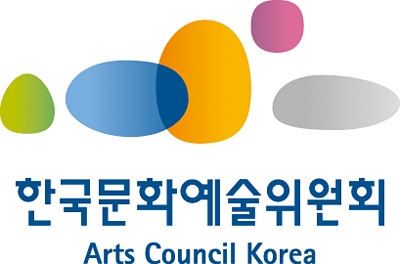
IN COOPERATION WITH
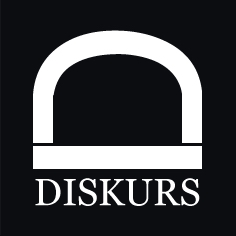 |
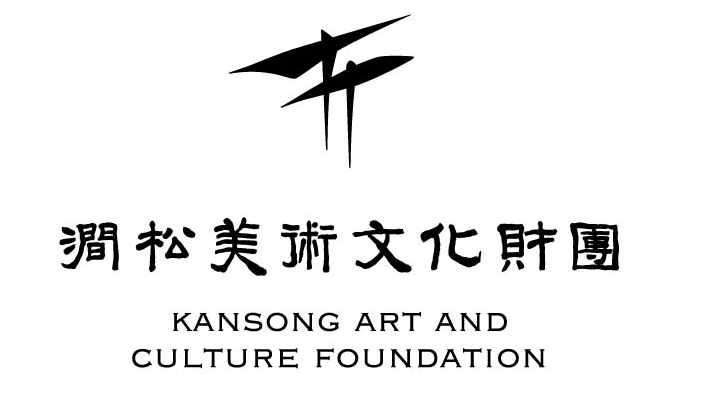 |
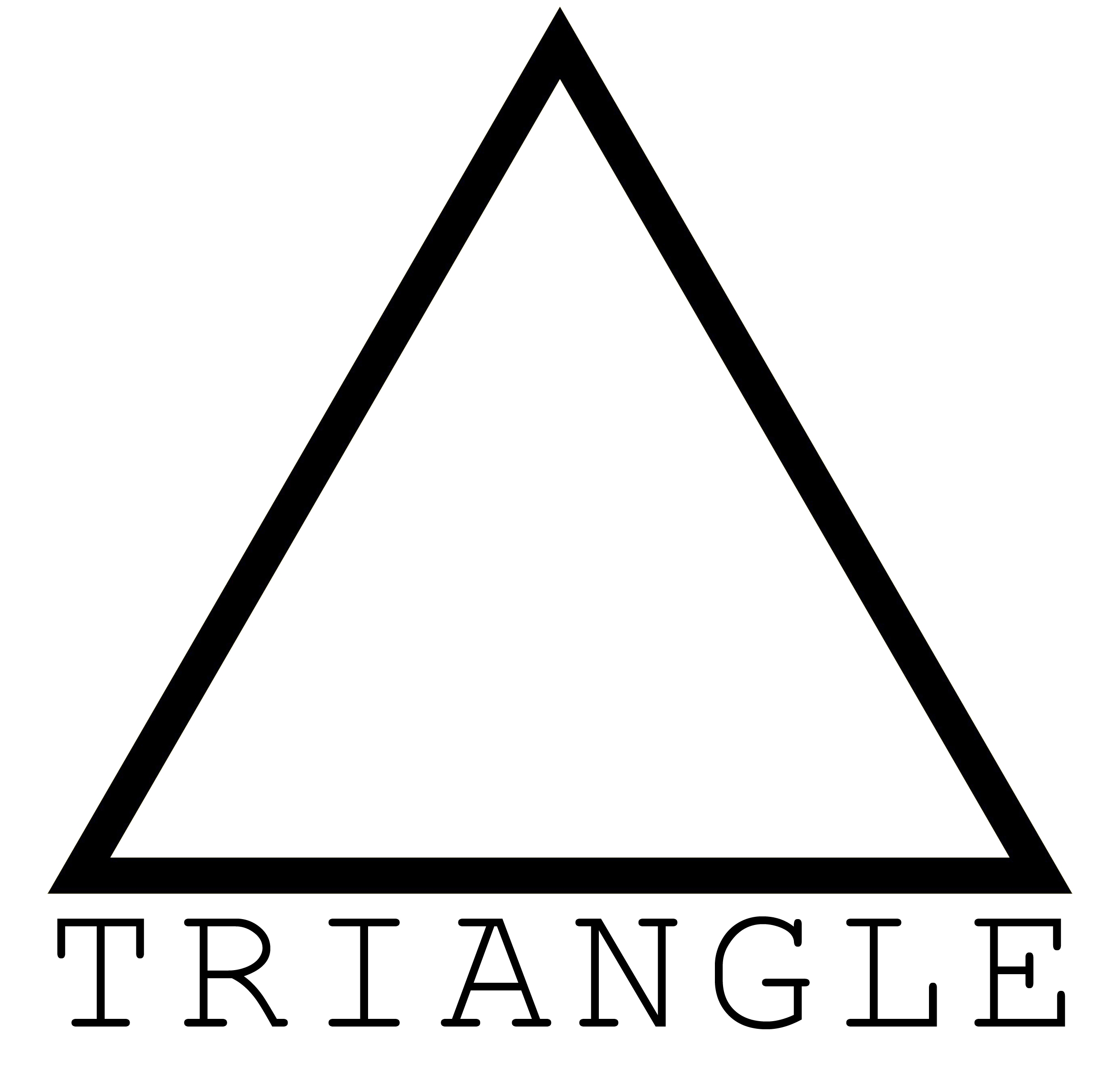 |
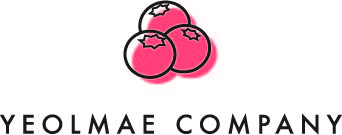 |
 |
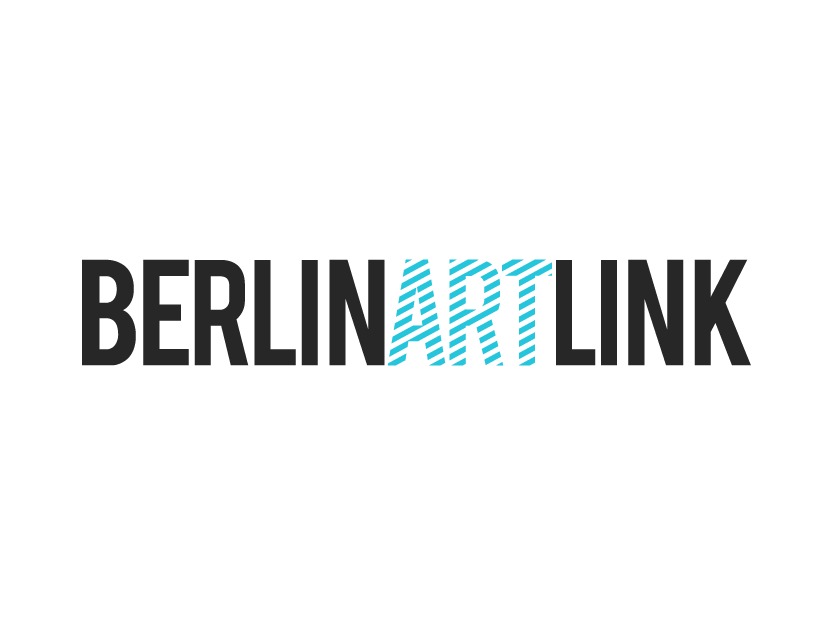 |


 Back to Homepage
Back to Homepage